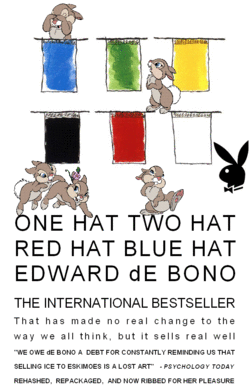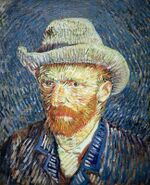Six Hats
The de Bono Hats system (also known as "Six Hats", "Six Thinking Hats", "Six Silly Hats", or "The Ministry of Silly Hats") is tools people either in a group, or as individuals, thinking. It is often combined with the idea of parallel thinking. The method is attributed to Dr. Edward de Bono and is the subject of his book, "Six Thinking Hats".
The method has been trialled within the UK civil service. This may explain the effectiveness of the UK civil service.
Michael Hewitt-Gleeson claims that the method was initially developed during a brainstorming session he had with Edward de Bono in 1983[1].
Underlying principles
The premise of the method is that the human brain thinks in a number of distinct ways. 5 of which have been identified, and as a result, de Bono came up with six hats. This allows those unable or unwilling to think to feel that they are a part of things too.
Five distinct states are identified
- Feeling (Red) - Girly stuff
- Negative judgement (Black) - Nihilism
- Positive Judgement (Yellow) - Greed
- Creative thinking (Green) - Constantly digressing
- Process control (Blue) - Thinking about thinking, but haven't yet decided to think
And the sixth hat[2]
- Neutrality (white) - Nothing - just nothing.
Dr de Bono asserts that these states are associated with distinct chemical states of the brain - although no details or evidence of this are presented. This may or may not be because it's a lie.
Parallel Thinking
In ordinary, unstructured thinking this process is unfocussed; the thinker leaps from critical thinking to neutrality to optimism and so on without structure or strategy. This is because most people are stupid, and without the teachings of de Bono[3], they wouldn't be able to think.
| “ | An individual thinking alone will come to an agreement A group thinking together will come to an argument. |
” |
The hats allow this to be avoided so that a consensus can be reached. This is achieved because everyone will put on a hat together, then they will all laugh at each other in their silly hats. Then they will put on another hat and laugh again. Amongst all this laughing nothing is decided as a group, and the person taking the notes tells them all what they decided later. This is what is referred to as "business intelligence."
Strategies and Programs
Having identified the six states that can be accessed, distinct programs can be created, these are sequences of hats which encompass and structure the thinking process toward a distinct goal.
Sequences always begin and end with a blue hat[4]; the group agrees together how they will think, then they do the thinking, then they get distracted, and they get hungry, and someone thinks of calling in for pizzas, and then someone starts putting up lots of pie graphs and diagrams, and then someone asks what it was they were supposed to be discussing again, and then they call in for drinks, and then it gets close to the end of the day, and then they decide to call it quits. The next morning they all get a copy of the minutes via e-mail, and they all agree that it was a very successful meeting, and they should have more like it in the future, but maybe they should have KFC instead next time.
Sequences (and indeed hats) may be used by individuals working alone or in groups.
Example programs
- Initial Ideas - Blue, White, Green, Blue
- Choosing between alternatives - Blue, White,(Green), Yellow, Black, Red, Blue
- Trying to remember what the last meeting was about - Blue, White, Black, Green, Blue
- Working out where to go for the work Christmas function - Blue, Red, Red, Red, Red, Red, Red, Blue
- Voting someone off the island - Blue, Yellow, Black, White, Blue, Green, Yellow, Black, White, Blue, Green, Blue
- What colour to paint the rainbow - Blue, Red and Yellow and Pink and Green, Orange and Purple and Blue[5]
- Solving Problems - Blue, White, Green, Red, Yellow, Black, Green, Blue
- Creative Problem Solving, otherwise referred to as solving the problems that were created by the last problem solving meeting. - Blue, Red, White, Yellow, Black, Green, Red, Blue
- Magic: The Gathering - ฺBlue, Red, Green, White, Black, Colorless
Types of hats
Included below is a brief description of each of the hats and the thinking processes that they represent. Their use is illustrated by examples from a typical commercial environment and also through the analysis of a simple classroom issue - "Students are talking while their teacher is talking".
White hat – Neutrality
Commercial examples are:
- Is anything happening?
- I don't know
Classroom examples are:
- Sorry, did you say something?
- Ummm...
Red hat – Feelings & Emotions
Participants state their feelings, exercising their gut instincts. In many cases this is a method for picking up by appearing to be loving and sensitive. This is useful when trying to decide what colours should be used in the office decorating scheme, and for forming an opinion about cushions and fabric samples. Unfortunately, in predominantly male groups, this is an excuse to start beating chests, hooting at each other, and in some extreme cases tossing faeces at each other.
Finally this hat can be used to request an aesthetic response to a particular design or object[6].
Commercial examples are:
- I think that the horizontal stripes add too much bulk to those designs.
- That role in the company doesn't appeal to me.
- How in the name of an ever loving God did he get a promotion when I didn't?
- Oooo! Aaaah aaaah aaaah! Oooo!
Classroom examples are:
- Samuel Smith! You put out that doobie right now young man!
- No, Samantha, I think that that shade of eyeshadow really brings out the blue in your eyes.
- Oooo! Aaaah aaaah aaaah! Oooo!
- Samuel Smith. This is Officer Daniels from the Armed Response Team. Why don't you send the hostages out son and we can talk about this?
Black hat – Critical Judgement
Participants identify barriers, bars, checks, difficulties, drawbacks, encumbrances, handicaps, hindrances, hurdles, impediments, limitations, obstacles, pales, preventives, restraints, restrictions, stumbling blocks, hazards, double troubles, dynamites, endangerments, hot potatoes, imperilments, menaces, perils, risks, risky businesses, thin ice, threats, and other negative connotations. They then realise they haven't got a hope and give up.
Commercial examples are:
- Stuff it.
- The animals I've trapped have all become my pets.
- I know, I know, a dirty word.
- There is a risk that new legislation will make this market unattractive.
Classroom examples are:
- Jeremy spoke in class today
- Pass the dutchie on the left hand side
- I wrote your name on my wrist with a razor blade
- Class, there's a pop quiz for you all today
Yellow hat – Positive Judgement
Participants identify benefits associated with an idea or issue. Then they try to work out how to twist it to their advantage. This is a self serving state and has no benefit to the group at all, and would not be included in the Six Hats methodology except that without this thinking the Six hats method would have gotten no commercial support. After all, what's in it for me? Without commercial support there would be no book sales, and hence no royalties.
Commercial examples are:
- That would be useful in market X
- I agree with the concept completely, but I believe that there should be a further increase in our salaries as well.
- Are we getting lunch provided with this meeting
- Is there any way to get back to the early 80s?
Classroom examples are:
- Is it time for lunch yet?
- What's in this for me?
- Gimme gimme gimme gimme!
- No, I'm sure that this was mine, I just left it in your bag for safe-keeping.
Green hat – Alternatives and learning
This is the hat of thinking new I wonder what is for How many of these can I fit in my Where did I leave that Oooh look, a pretty butterfly! Yes, this is a hat of I know where I left it again. The hat of If I stick three of them in my left nostril while holding the others in my right. The hat Maybe I should have that salmon and egg pie again. I give up.
Commercial examples are:
- Oooh look, a pretty butterfly!
- What if we provided it for free?
- Hey, I think I can access online games from here.
- Check out this Uncyclopedia article!
Classroom examples are:
- Is it time for lunch yet?
- Hey, watch what happens when I light my fart![7]
- She's really cute. I wonder what colour panties she's wearing.
- Check out this Uncyclopedia article on swimming. I should edit it and say that Gareth Kean is a pervert!
Blue hat – The Big Picture
This is the hat under which all participants discuss the thinking process. Once they have discussed the thinking process they will then discuss what it was they were thinking while they were discussing the thinking process. Once they have discussed what it was they were thinking while they were discussing the thinking process they will then discuss what it was they were thinking while they were discussing what it was they were thinking while they were discussing the thinking process.
The facilitator will generally wear it throughout and ensure that they constantly think about what they are thinking about while the group are thinking about what it is that they are thinking about. In this way the facilitator will not interfere with the thinking process of the group and therefore everyone can get on with what they were doing.
Commercial examples are:
- We'll follow this program of thinking to start the day - What does everyone think?
- I think, therefore I am
- If there is thought, then there must be a thinker, but am I really thinking or do I just think that I'm thinking.
- Man, what was in those cookies.
Classroom examples are negligible, as nobody thinks in the classroom[8].
Application Method
Whilst the ideas of the hats themselves provides significant benefits, there is more to the six hats method as applied within de Bono thinking systems and as trained under his franchise[9]. In order to know the full extent of the application of the Six Hats methodology, you will need to have de Bono Six Thinking Hats Certification. (Please note that this s separate from Lateral Thinking Certification, Course in Creativity Certification, Simplicity Certification, or any other de Bono Certification.)
Training is available in all of these areas. de Bono Consulting currently offers a combined Six Thinking Hats Certification and Focus on Facilitation Accreditation for as little as USD$5,250[10]. However due to demand by an adoring public, details of the application are detailed below.
Typically a project will start with - Remainder removed due to potential infringement of copyright[11].
Summary
Using a variety of approaches within thinking and problem solving allows everyone to feel that the issue has been addressed from a variety of angles, thus servicing the needs of all individuals concerned. The reality is that the issues has been address by the perspective of one person, and one person alone. This is generally not the Boss, as most people mistakenly believe, but the Boss's Personal Assistant.
In this way people believe that the world is fair and lovely, and that puppy dogs and kittens play happily in the park, while their immortal souls are crushed beneath the weight of the evil corporate hierarchy.
It is also a fantastic opportunity to get your workmates into stupid hats, get them drunk, and then bet then to pose in embarrassing and potentially career destroying poses, so that you may use this to grease your way up the corporate ladder, and eventually become the boss yourself. This is what is referred to as Corporate Thinking.
Publication data
- Edward De Bono. One Hat, Two Hat, Red Hat, Blue Hat (1985) ISBN N-E14-10-IS
See also
References
- ↑ And de Bono snatched the idea away from me and my School of Thinking And he wants to become King of Australia. Does this man's sense of entitlement know no bounds! But did he give any attribution. Oh no, de Bono! He mercilessly snatched the idea and published it. It is a fact which Edward de Bono has been forced to admit, in writing. And not only that, he ignored the seventh hat, and swapped the blue hat and the green hat around. This man's evil knows no bounds!
- - Michael Hewitt-Gleeson on Edward de Bono
- ↑ The much alluded to seventh hat is no longer with the six hats, and left prior to the six hats reaching stardom, much like the fifth Beatle. Ironically then, this refers to wisdom. Vincent van Gogh wore a grey hat, and he cut off his own ear, so he must have been wise.
But the seven hats is right. Edward de Bono is wrong and I'm right, despite what he names his books!
- - Michael Hewitt-Gleeson on the seventh hat
- ↑ It should be the teachings of Michael Hewitt-Gleeson
- - Michael Hewitt-Gleeson on Michael Hewitt-Gleeson
- ↑ Because the inventors got together as a group and discussed how to start and end the meetings and it was decided that it would be the blue hat. It must have been decided on. No one can quite remember the decision being made as they were laughing so much about the idea of getting everyone to wear headbands and baseball caps. And they were all laughing. But the minutes read that that was the decision, and as that was a decision made by the group then that was the decision they were sticking with.
- ↑ I can sing a rainbow, sing a rainbow, sing a rainbow tune. Apologies to all you Indigo fans out there.
- ↑ We don't really know what this means either. Must be some type of girly thing.
- ↑ Also a well known alternative to waxing.
- ↑ Don't try and argue with me! Really! I know how to use big words like onomatopoeia, so "Woof!"
- ↑
Yes, there is the seventh hat, the Grey hat, Wisdom.
IThe Grey hat is most often worn by the person taking the notes, who also happen to be the person who called the meeting. While this person will generally keeps quiet during the meeting, they will sit there and write down what everyone believes is what everyone is saying. This is also the person who writes the agenda for the meeting, and e-mails the minutes out to everyone the next day. They are the person who arranges that drinks be arranged for everyone, and is the first to hand out cookies.
IAnd as long as I live, I will never again allow de Bono to wear a Grey hat
- - Michael Hewitt-Gleeson still on the seventh hat
- ↑ For those interested in signing up, more details can be found here.
- ↑ Because even though Uncyclopedia is protected by parody, de Bono is a litigious bastard.
- ↑ I hate you de Bono, and I will get you! By all that is holy and sacred, I swear I will get you! No, don't stop reading the article. Come to my School of Thinking. Nooooo!
- - Michael Hewitt-Gleeson on a never-ending rant
| This page was originally sporked from Wikipedia and School of Thinking. |
| Featured version: 10 August 2009 | |
| This article has been featured on the main page. — You can vote for or nominate your favourite articles at Uncyclopedia:VFH. | |











